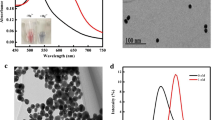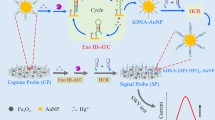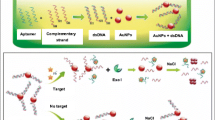Abstract
With the development of exonuclease, the exonuclease has been used to construct a variety of aptasensor and to realize the signal amplification. Among them, based on silver nanoparticles (Ag NPs) and exonuclease I (Exo I)-assisted cycle signal amplification strategy, we designed a novel high-sensitivity dual-target electrochemical biosensor to detect Pb2+ or Hg2+ in water. In the presence of Hg2+, the Hg2+ was fixed to the aptamer chain by thymine-Hg2+-thymine (T-Hg2+-T), resulting in the decrease of signal. When Pb2+ was present, DNA single strand S2 dissociated and was bound to Pb2+, which automatically triggered Exo I to selectively cut the single chain from the recognition site to achieve the cyclic amplification of the electrochemical signal. The interaction between aptamer and Exo I was investigated by gel electrophoresis. Under the optimum conditions in the scan range -0.20 to 0.60 V, the biosensor had high sensitivity with a linear range of 100 pg/L to 10.0 mg/L, Pb2+ or Hg2+, and the detection limits were 17.0 pg/L (R2 = 0.993) and 12.0 pg/L (R2 = 0.993), respectively. The relative standard deviation (RSD) of the sensor was 0.5–2.6%, and the recovery of spiked standard solutions was between 98.3 and 110%. The cycle amplification strategy supported by this enzyme has promising applications in detection of the two metal ions in various fields.
Graphical Abstract







Similar content being viewed by others
References
Vashisht D, Kaur K, Jukaria R, Vashish A, Sharma S, Meht SK (2019) Colorimetric chemosensor based on coumarin skeleton for selective naked eye detection of cobalt(II) ion in near aqueous medium. Sens Actuators B Chem 280219-226.https://doi.org/10.1016/j.snb.2018.10.020
Pan F, Tong CY, Wang ZY, Hao HH, Liu P, Pan DW, Zhu RL (2021) Nanocomposite based on graphene and intercalated covalent organic frameworks with hydrosulphonyl groups for electrochemical determination of heavy metal ions. Microchim Acta 188-295.https://doi.org/10.1007/s00604-021-04956-1
Soylak M, Alasaad M, Özalp Ö (2022) Fabrication and characterization of MgCo2O4 for solid phase extraction of Pb(II) from environmental samples and its detection with high-resolution continuum source flame atomic absorption spectrometry (HR-CS-FAAS). Microchem J 178:107329. https://doi.org/10.1016/j.microc.2022.107329
Hwang HJ, Hwang GH, Ahn SM, Kim YY, Shin HS (2022) Risk assessment and determination of heavy metals in home meal replacement products by using inductively coupled plasma mass spectrometry and direct mercury analyzer. Foods 11:504. https://doi.org/10.3390/foods11040504
Xu C, He M, Chen BB, Hu B (2022) Magnetic porous coordination networks for preconcentration of various metal ions from environmental water followed by inductively coupled plasma mass spectrometry detection. Talanta 245:123470. https://doi.org/10.1016/j.talanta.2022.123470
Jiang CM, Li XJ, Yao Y, Lan LY, Shao YZ, Zhao FN, Ying YB, Ping JF (2020) A multifunctional and highly flexible triboelectric nanogenerator based on MXene-enabled porous film integrated with laser-induced graphene electrode. Nano Energy 66:104121. https://doi.org/10.1016/j.nanoen.2019.104121
Ninwong B, Ratnarathorn N, Henry CS, Mace CR, Dungchai W (2020) Dual sample preconcentration for simultaneous quantification of metal ions using electrochemical and colorimetric assays. ACS Sens 5:3999–4008. https://doi.org/10.1021/acssensors.0c01793
Liu ML, Li TT, Zhang C, Zheng Y, Wu CQ, Zhang J, Zhang K, Zhang ZP (2021) Fluorescent carbon dots embedded in mesoporous silica nanospheres: a simple platform for Cr(VI) detection in environmental water. J Hazard Mater 415:125699. https://doi.org/10.1016/j.jhazmat.2021.125699
Shao YZ, Yao Y, Jiang CM, Zhao FN, Liu XX, Ying YB, Ping JF (2019) Two-dimensional MXene nanosheets (types Ti3C2Tx and Ti2CTx) as new ion-to-electron transducers in solid-contact calcium ion-selective electrodes. Microchim Acta 186:750. https://doi.org/10.1007/s00604-019-3878-7
Gabris MA, Ping JF (2021) Carbon nanomaterial-based nanogenerators for harvesting energy from environment. Nano Energy 90:106592. https://doi.org/10.1016/j.nanoen.2021.106494
Li Y, Huang H, Cui RL, Wang DM, Yin Z, Wang D, Zheng LR, Zhang J, Zhao YD, Yuan H, Dong JQ, Guo XH, Sun BY (2021) Electrochemical sensor based on graphdiyne is effectively used to determine Cd2+ and Pb2+ in water. Sens Actuators B Chem 332:129519. https://doi.org/10.1016/j.snb.2021.129519
Song XL, Wang Y, Liu S, Zhang X, Wang HW, Wang JF, Huang JD (2018) Ultrasensitive electrochemical detection of Hg2+ based on an Hg2+-triggered exonuclease III-assisted target recycling strategy. Analyst 143:5771. https://doi.org/10.1039/C8AN01409D
Singh S, Arshid N, Zhang YQ, Huang TV (2020) A novel highly efficient and ultrasensitive electrochemical detection of toxic mercury (II) ions in canned tuna fish and tap water based on a copper metal-organic framework. J Hazard Mater 339:123042. https://doi.org/10.1016/j.jhazmat.2020.123042
Attias R, Dlugatch B, Chate MS, Goffer Y, Aurbach D (2021) Changes in the interfacial charge-transfer resistanceof Mg metal electrodes, measured by dynamic electrochemical impedance spectroscopy. Electrochem Commun 124:106952. https://doi.org/10.1016/j.elecom.2021.106952
Rajaji U, Chinnapaiyan S, Chen SM, Mani G, Alothman AA, Alshgari RA (2021) Bismuth telluride decorated on graphitic carbon nitrides based binary nanosheets: Its application in electrochemical determination of salbutamol (feed additive) in meat samples. J Hazard Mater 413:125265. https://doi.org/10.1016/j.jhazmat.2021.125265
Saisree S, Aswathi R, Arya Nair JS, Sandhya KY (2021) Radical sensitivity and selectivity in the electrochemical sensing of cadmium ions in water by polyaniline-derived nitrogen-doped graphene quantum dots. RSC 45:110–122. https://doi.org/10.1039/D0NJ03988H
Mslskootian M, Hamzeh S, Mahmoudi-Moghaddam H (2020) A new electrochemical sensor for simultaneous determination of Cd (II) and Pb (II) using FeNi3/CuS/BioCl:RSM optimization. Microchem J 158:105194. https://doi.org/10.1016/j.microc.2020.105194
Lee CS, Yu SH, Kim TH (2020) A “turn-on” electrochemical aptasensor for ultrasensitive detection of Cd2+ using duplexed aptamer switch on electrochemically reduced graphene oxide electrode. Microchem J 159:105372. https://doi.org/10.1016/j.microc.2020.105372
Pal C, Majumder S (2020) Ultra-low-level detection of mercury (Hg2+) heavy metal carcinogens in aqueous medium using electrochemistry. Mater Today 29:1129–1131. https://doi.org/10.1016/j.matpr.2020.05.336
Butmee P, Mala J, Damphathik C, Kunpatee K, Tumcharern G, Kerr M, Mehmeti E, Raber G, Kalcher K, Samphao A (2021) A portable selective selectrochemical sensor amplified with Fe3O4@Au-cysteamine-thymine acetic acid as conductive madiator for derermination of mercuric ion. Talanta 221:121669. https://doi.org/10.1016/j.talanta.2020.121669
Muppidathi M, Perumal P (2020) Fluerescent pllyaniline nanoclios (PANCs): a highly sensitive and selective chemical sensor for the detection of Hg(II) lons in aqueous media. ChemistrySelecet. 54481-4487.https://doi.org/10.1002/slct.202000545
Baek S, Ahn JK, Won BY, Park KS, Park HG (2019) A one-step and label-free, electrochemical DNA detection using metal ion-mediated molecular beacon probe. Electrochem Commun 100:64–69. https://doi.org/10.1016/j.elecom.2019.01.023
Martin AA, Fodjo EK, Eric-Simon ZV, Gu Z, Yang GX, Albrt T, Kong C, Wang HF (2021) Cys-AgNPs modified gold electrode as an ultrasensitive electrochemical sensor for the detection of 3-chloropropane-1,2-diol. Arab J Chem 14:103319. https://doi.org/10.1016/j.arabjc.2021.103319
Cheng ST, Liu HM, Zhang H, Chu GL, Guo YM, Sun X (2019) Ultrasensitive electrochemiluminescence aptasensor for kanamycin detection based on silver nanoparticle-catalyzed chemiluminescent reaction between luminol and hydrogen peroxide. Sens Actuators B Chem 304:127367. https://doi.org/10.1016/j.snb.2019.127367
Tümay SO, Yeilot S (2021) Highly selective “turn-on” fluorescence determination of mercury ion in food and environmental samples through novel anthracene and pyrene appended Schiff bases. J Photochem Photobiol A 407:113093. https://doi.org/10.1016/j.jphotochem.2020.113093
Raju CV, Kumar SS (2021) Co-reactant-free self-enhanced solid-state electrochemiluminescence platform based on polyluminol-gold nanocomposite for signal-on detection of mercury ion. Sci Rep 11:6932. https://doi.org/10.1038/s41598-021-86195-1
Saenchoopa A, Boonta W, Talodthaisong C, Srichaiyapol O, Patramanon R, Kulchat S (2021) Colorimetric detection of Hg(II) by γ-aminobutyric acid-silver nanoparticles in water and the assessment of antibacterial activities. Spectrochim Acta A Mol Biomol Spectrosc 251:119433. https://doi.org/10.1016/j.saa.2021.119433
Kumar A, Chare PS (2019) Fluorescence tunable thiophene-bis(benzimidazole)-based probes for a cascade trace detection of Hg2+ and lysine: a molecular switch mimic. Sens Actuators B Chem 15:933–944. https://doi.org/10.1016/j.snb.2018.11.023
Han JJ, Yu JG, Guo YF, Wang L, Song YH (2020) COFBTLP-1/three-dimensional macroporous carbon electrode for simultaneous electrochemical detection of Cd2+, Pb2+, Cu2+ and Hg2+. Sens Actuators B Chem 321:128498. https://doi.org/10.1016/j.snb.2020.128498
Rahimi H, Hosseinzadeh R, Tajbakhsh M (2021) A new and efficient pyridine-2,6-dicarboxamide-based fluorescent and colorimetric chemosensor for sensitive and selective recognition of Pb2+ and Cu2+. J Photochem Photobiol A 407:113049. https://doi.org/10.1016/j.jphotochem.2020.113049
Li XJ, Jiang CM, Yao Y, Zhang Q, Dai SF, Ying YB, Ping JF (2021) Growth-controllable triboelectric nanogenerator based on surface-attached metalorganic framework layer on living leaf. Small 17:2103430. https://doi.org/10.1002/smll.202103430
Yin JQ, Chu GL, Wang Y, Zhai HG, Wang B, Sun X, Guo YM, Zhang YY (2021) Novel three-dimensional sensor for rapid detection of Pb(II) and Cd(II) in edible mushrooms. Electroanalysis 33:1–9. https://doi.org/10.1002/elan.202060560
Acknowledgements
The authors gratefully acknowledge the financial support provided all the funds.
Funding
This work was supported by the Natural Science Foundation of Shandong Province (ZR2018BC055) and the National Natural Science Foundation of China (No.32161133008).
Author information
Authors and Affiliations
Contributions
Yue Wang: conceptualization, methodology, writing—original draft.
Hongguo Zhai: methodology, writing—review & editing.
Jiaqi Yin: investigation, writing—review & editing.
Qi Guo: date curation.
Yuhao Zhang: date curation.
Qingqing Yang: validation, investigation.
Falan Li: Resources, writing—review & editing.
Xia Sun: formal analysis.
Yemin Guo: formal analysis.
Yanyan Zhang: supervision, funding acquisition.
Corresponding author
Ethics declarations
Conflict of interest
The authors declare no competing interests.
Additional information
Publisher's note
Springer Nature remains neutral with regard to jurisdictional claims in published maps and institutional affiliations.
Supplementary Information
Below is the link to the electronic supplementary material.
Rights and permissions
Springer Nature or its licensor (e.g. a society or other partner) holds exclusive rights to this article under a publishing agreement with the author(s) or other rightsholder(s); author self-archiving of the accepted manuscript version of this article is solely governed by the terms of such publishing agreement and applicable law.
About this article
Cite this article
Wang, Y., Zhai, H., Yin, J. et al. Dual-target electrochemical DNA sensor for detection of Pb2+ and Hg2+ simultaneously by exonuclease I–assisted recycling signal amplification. Microchim Acta 189, 460 (2022). https://doi.org/10.1007/s00604-022-05569-y
Received:
Accepted:
Published:
DOI: https://doi.org/10.1007/s00604-022-05569-y




